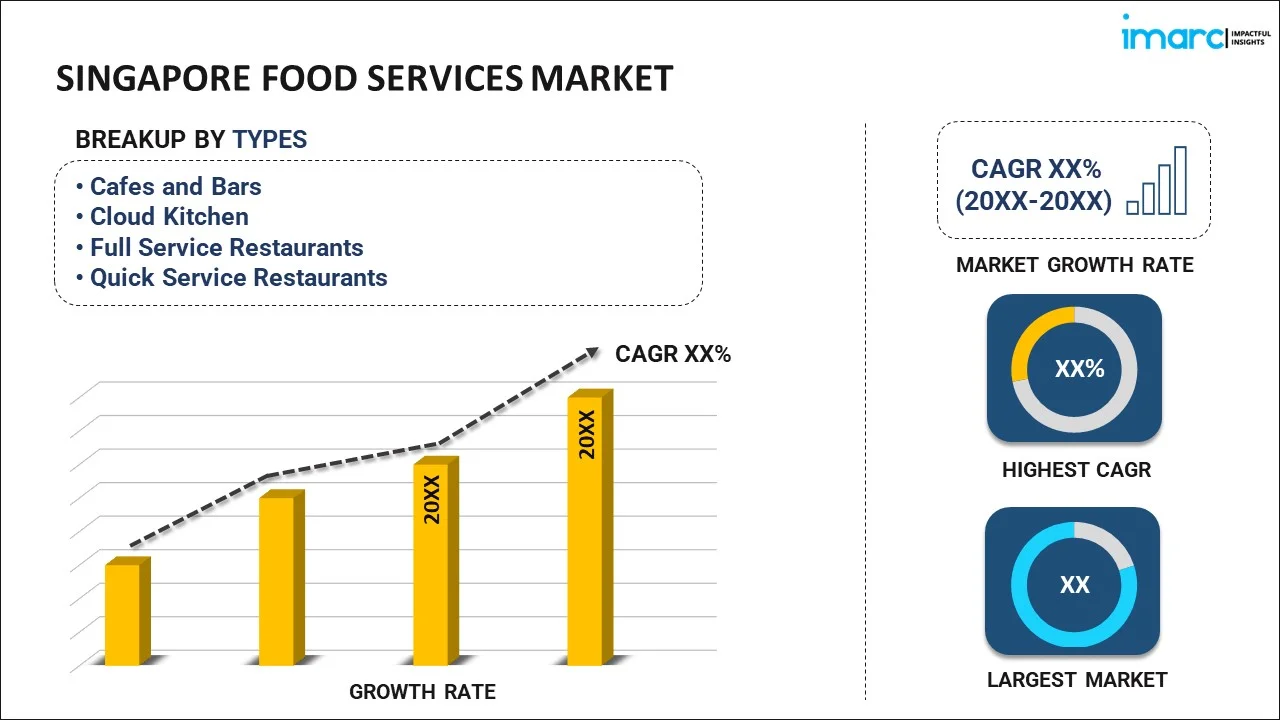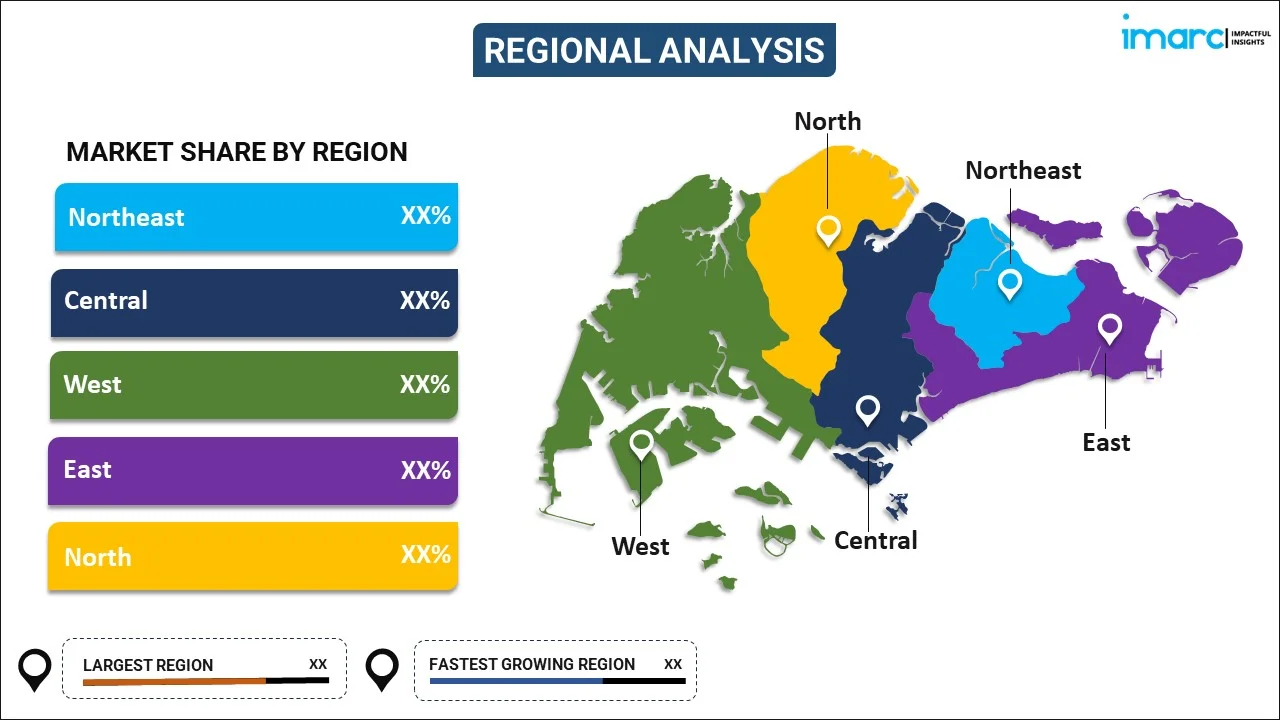
Singapore Food Services Market Report by Type (Cafes and Bars, Cloud Kitchen, Full Service Restaurants, Quick Service Restaurants), Outlet (Chained Outlets, Independent Outlets), Location (Leisure, Lodging, Retail, Standalone, Travel), and Region 2025-2033
Singapore Food Services Market Overview:
The Singapore food services market size is projected to exhibit a growth rate (CAGR) of 15.11% duringn2025-2033. The rising disposable incomes, diverse culinary preferences, increasing demand for convenience and delivery services, tourism growth, and a thriving dining-out culture supported by innovative and tech-savvy dining experiences are some of the major key factors strengthening the market growth.
|
Report Attribute
|
Key Statistics
|
|---|---|
|
Base Year
|
2024 |
|
Forecast Years
|
2025-2033 |
|
Historical Years
|
2019-2024
|
| Market Growth Rate (2025-2033) | 15.11% |
Singapore Food Services Market Trends:
Rise of food delivery and takeaway services
One of the most prominent trends in the Singapore food services market is the substantial growth of food delivery and takeaway services. This trend has been heightened by the COVID-19 pandemic, which significantly increased the demand for contactless dining options. Companies have capitalized on this demand by expanding their services and offering a wide variety of cuisines from numerous restaurants. In line with this, a survey made by Deliveroo revealed that 68% of people utilize food delivery daily, with 80% expecting increased usage in the next year. Online ordering has increased as a result of consumers' appreciation for the security and ease of having meals delivered to their homes or workplaces. Additionally, the proliferation of cloud kitchens, which focus exclusively on delivery and takeaway without a physical dining space, is contributing to the market expansion.
Increasing demand for healthy and sustainable dining options
With the growing awareness of health and environmental issues, consumers are increasingly seeking out restaurants and food service providers that offer nutritious, organic, and sustainably sourced foods. The popularity of plant-based menus, which appeal to diners who are concerned about their health and the environmental effects of eating meat, is a reflection of this trend. As a result, restaurants are also responding to this trend by incorporating more locally sourced ingredients to reduce their carbon footprint and support local farmers. Moreover, there is a growing emphasis on transparency, with establishments providing detailed information about the nutritional content and sourcing of their ingredients, which is bolstering the market growth.
Integration of technology to enhance the dining experience
From online reservations and digital menus to contactless payments and virtual waitlists, technology is enhancing the overall dining experience for consumers. Restaurants are using data analytics to better understand their patrons' preferences and tailor their menus, which enhances customer satisfaction and loyalty. Mobile apps and loyalty programs are also becoming more sophisticated, offering tailored promotions and rewards to frequent diners. Modern kitchen technology is also optimizing workflows, raising productivity, and cutting waste. For instance, automated systems for inventory management and food preparation are helping restaurants maintain consistency and quality while minimizing costs. Augmented reality (AR) and virtual reality (VR) are being explored to create immersive dining experiences that attract tech-savvy customers. The use of technology enhances convenience and efficiency for both customers and operators and allows for innovative and memorable dining experiences, thus providing an impetus to the market demand.
Singapore Food Services Market News:
- In May 2023, Starbucks inaugurated the latest rustic finish store in Bird Paradise, and the structure of the store is designed like a wooden hut.
- In April 2023, Din Tai Fung introduced Molten KITKAT® lava buns, officially called Cocoa Nutty Buns, at all outlets until 31 May 2023. Priced at S$9 for 3, these buns feature a filling of KITKAT® spread and wafer bits, earning them the nickname "KITKAT® buns."
Singapore Food Services Market Segmentation:
IMARC Group provides an analysis of the key trends in each segment of the market, along with forecasts at the country level for 2025-2033. Our report has categorized the market based on type, outlet, and location.
Type Insights:

- Cafes and Bars
- By Cuisine
- Bars and Pubs
- Cafes
- Juice/Smoothie/Desserts Bars
- Specialist Coffee and Tea Shops
- Cloud Kitchen
- Full Service Restaurants
- By Cuisine
- Asian
- European
- Latin American
- Middle Eastern
- North American
- Others
- Quick Service Restaurants
- By Cuisine
- Bakeries
- Burger
- Ice Cream
- Meat-based Cuisines
- Pizza
- Others
The report has provided a detailed breakup and analysis of the market based on the foodservice type. This includes cafes and bars (bars and pubs, cafes, juice/smoothie/desserts bars, and specialist coffee and tea shops), cloud kitchen, full service restaurants (asian, european, latin american, middle eastern, north american, and others), and quick service restaurants (bakeries, burger, ice cream, meat-based cuisines, pizza, and others).
Outlet Insights:
- Chained Outlets
- Independent Outlets
A detailed breakup and analysis of the market based on the outlet have also been provided in the report. This includes chained outlets and independent outlets.
Location Insights:
- Leisure
- Lodging
- Retail
- Standalone
- Travel
The report has provided a detailed breakup and analysis of the market based on the location. This includes leisure, lodging, retail, standalone, and travel.
Regional Insights:

- North-East
- Central
- West
- East
- North
The report has also provided a comprehensive analysis of all the major regional markets, which include North-East, Central, West, East, and North.
Competitive Landscape:
The market research report has also provided a comprehensive analysis of the competitive landscape. Competitive analysis such as market structure, key player positioning, top winning strategies, competitive dashboard, and company evaluation quadrant has been covered in the report. Also, detailed profiles of all major companies have been provided.
Singapore Food Services Market Report Coverage:
| Report Features | Details |
|---|---|
| Base Year of the Analysis | 2024 |
| Historical Period | 2019-2024 |
| Forecast Period | 2025-2033 |
| Units | Billion USD |
| Scope of the Report | Exploration of Historical Trends and Market Outlook, Industry Catalysts and Challenges, Segment-Wise Historical and Future Market Assessment:
|
| Types Covered |
|
| Outlets Covered | Chained Outlets, Independent Outlets |
| Locations Covered | Leisure, Lodging, Retail, Standalone, Travel |
| Regions Covered | North-East, Central, West, East, North |
| Customization Scope | 10% Free Customization |
| Post-Sale Analyst Support | 10-12 Weeks |
| Delivery Format | PDF and Excel through Email (We can also provide the editable version of the report in PPT/Word format on special request) |
Key Questions Answered in This Report:
- How has the Singapore food services market performed so far and how will it perform in the coming years?
- What has been the impact of COVID-19 on the Singapore food services market?
- What is the breakup of the Singapore food services market on the basis of type?
- What is the breakup of the Singapore food services market on the basis of outlet?
- What is the breakup of the Singapore food services market on the basis of location?
- What are the various stages in the value chain of the Singapore food services market?
- What are the key driving factors and challenges in the Singapore food services?
- What is the structure of the Singapore food services market and who are the key players?
- What is the degree of competition in the Singapore food services market?
Key Benefits for Stakeholders:
- IMARC’s industry report offers a comprehensive quantitative analysis of various market segments, historical and current market trends, market forecasts, and dynamics of the Singapore food services market from 2019-2033.
- The research report provides the latest information on the market drivers, challenges, and opportunities in the Singapore food services market.
- Porter's five forces analysis assist stakeholders in assessing the impact of new entrants, competitive rivalry, supplier power, buyer power, and the threat of substitution. It helps stakeholders to analyze the level of competition within the Singapore food services industry and its attractiveness.
- Competitive landscape allows stakeholders to understand their competitive environment and provides an insight into the current positions of key players in the market.
Need more help?
- Speak to our experienced analysts for insights on the current market scenarios.
- Include additional segments and countries to customize the report as per your requirement.
- Gain an unparalleled competitive advantage in your domain by understanding how to utilize the report and positively impacting your operations and revenue.
- For further assistance, please connect with our analysts.
 Inquire Before Buying
Inquire Before Buying
 Speak to an Analyst
Speak to an Analyst
 Request Brochure
Request Brochure
 Request Customization
Request Customization




.webp)




.webp)












